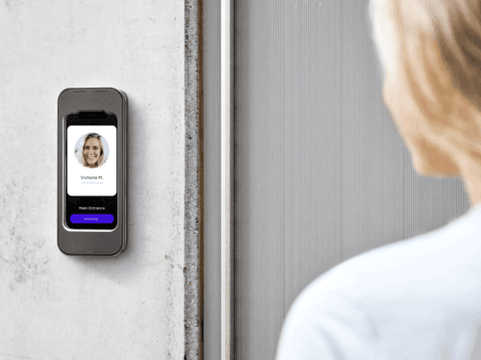It’s no secret that food deliveries would have seen a major increase in 2020. We took a look at how food deliveries were handled in apartment buildings this past year, identified security issues with the influx of orders, and came up with recommendations for a better management system that will not compromise safety.
Table of contents
Suggested Posts:
- Challenges of Modern Apartment Delivery Management
- Solve Multifamily Package Management Challenges
- What To Do About Pandemic Porch Pirates and Package Theft
Food Delivery Rates During COVID-19
As restaurants were forced to shut down indoor dining, and people feared going out in public, food delivery became a huge commodity during the height of the pandemic. Food delivery app downloads spiked, as did revenue for those companies.
DoorDash, a popular food delivery app, controls 45% of the food delivery market in the US. In April 2020, DoorDash was the most downloaded food delivery app with more than 4.1 million installs within the month alone. This single month of downloads accounted for approximately a quarter of total DoorDash users in 2020. This increase from April also reflected a 72.4% increase from April 2019.
Similarly, GrubHub, another popular food delivery app, increased their fourth quarter revenue by almost 50% from 2019. Their Q4 revenue only saw a 19% increase from 2018 .
Needless to say, food delivery played a big role in 2020.
3 Security Issues With Food Delivery in Apartment Buildings
With the clear growth of food delivery throughout the pandemic, there are also several security issues to consider for apartment buildings specifically.
1. Bottleneck of Delivery People
Apartment buildings deliveries are different from single-family home deliveries. Delivery people need to be able to make it into the building to complete their delivery. So, during peak delivery times such as lunch or dinner, delivery people find themselves bottlenecked outside the front door of the apartment building. There are two safety concerns when this happens.
The first safety concern is COVID-19. As we know, it’s not safe to have a group of individuals gathered within close proximity of one another, which is what happens when delivery people are bottlenecked at the front entrance of a building. Further, even after a group of delivery people are granted access, either by a tenant or building staff, they are still clumped together at the elevator or in the lobby.
The second concern is perception. Many people standing at the entrance of a building and all being let in together without any additional verification upon entrance to the building does not align well with physical security best practices. This poses a security risk for unauthorized visitors who are able to see a clear vulnerability in building security.
2. Risks of Tailgating
The perceived security risk from bottlenecked drivers being given authorization in mass translates to the risk of tailgating. Food delivery personnel risk an unauthorized person tailgating them into the building. This does not just apply to mass building entry from bottlenecked deliveries. Tailgating is always a security risk for any number of delivery people gaining access to a building. This is true for package deliveries and other building visitors, as well. In fact, for some apartment buildings, food delivery workers are encouraged to tailgate other residents to gain access to the building in order to make their delivery.
3. Delivery People as Targets for Theft
Delivering pizza is one of the most dangerous jobs in America. Particularly when food deliveries are made at night, there is significant risk of theft when the delivery person is not immediately allowed access to the building. Food delivery workers also increase their chances of becoming targets for crime when they are not familiar with their surroundings and could be caught off guard. For example, if they are seen looking for the correct entrance or wandering to find alternate means of entrance to the building.
5 Ways to Securely Manage Food Delivery
As food delivery becomes more common and continues to be a necessity through the pandemic, apartment buildings can implement better precautions to protect their residents and those visiting their building.
1. Upgrading to a Video Intercom System
Most, if not all, modern apartment buildings have an intercom or apartment buzzer system to notify residents when they have a visitor. Unfortunately, these systems can still cause security issues if they do not incorporate any type of visual verification or they are not intuitive enough for a delivery person to use. Installing a simple video intercom system is one answer to better food delivery management if property managers or owners are looking for a permanent, efficient solution.
Previously, installing an intercom system was a major building project. It required in-unit installation for all residents and wiring throughout the building, which is time-consuming, expensive, inconvenient, and leaves security gaps. Now, however, installing a wireless intercom system has become the popular solution for apartment buildings. Wireless intercoms, which now offer advanced video capability, have fast, simple installation for apartments to quickly deploy a secure video intercom system.
2. Use PIN Codes for Delivery Instruction
Delivery apps or online delivery orders usually have a field for special delivery instructions. If the apartment building has a modern intercom system, the tenant can generate a one-time or single-use PIN code to input in the instruction section to give the delivery drive quick, frictionless access to the buildings upon arrival.
3. Designate a Drop-Off Zone for Food Deliveries
If apartment buildings do not want to upgrade to a video intercom system nor do they have property technology installed that generates visitor PIN codes, property managers can always designate a drop off zone for food delivery workers within the apartment buildings. This, of course, would require that the apartment building allow visitor access to a lobby or common area that anyone could access at any time, which poses its own security risks.
4. Curbside Pickup
Similar to designating a drop off zone for food deliveries, property managers can coordinate a curbside pickup system. This would require more cooperation and responsibility on the tenant’s end, but it is a quick and secure solution to food delivery management that has the delivery person’s safety in mind.
5. Offer a Food Amenity Service
Apartment and multifamily building amenities are how property managers are setting themselves apart in order to stay competitive in the rental market. While fitness, wellness, and outdoor amenities are commonly thought of as the most “in-demand,” tenants are becoming more and more interested in having food amenities on site. By partnering with local restaurants through services like 2ndKitchen, property managers create a safe alternative to food delivery while also providing more value to their tenants.
Need help with food delivery management?
Get in touch with a Swiftlane specialist to find the right solution for managing food deliveries in your building.



